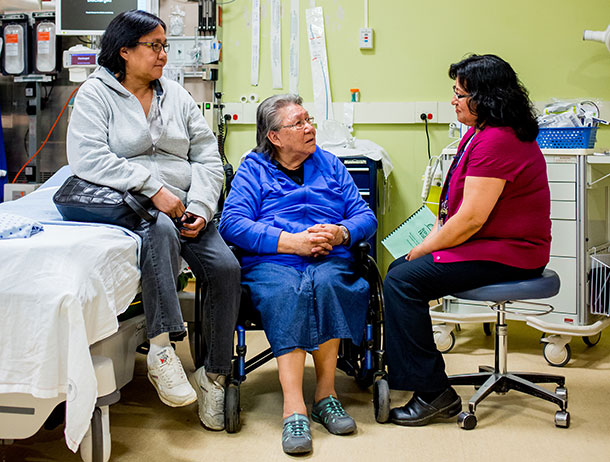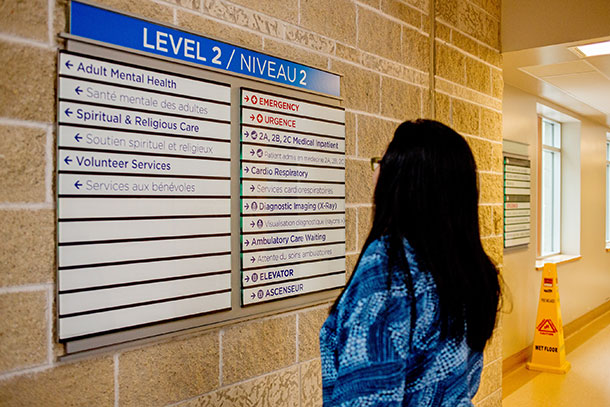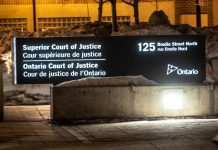
THUNDER BAY – HEALTH – For many people living in First Nation communities across Northwestern Ontario, coming to the Thunder Bay Regional Health Sciences Centre (TBRHSC) for medical treatment is their first trip to Thunder Bay. Adjusting to the big city away from friends and family can be difficult, especially for those whose first language is not English. TBRHSC is committed to enhancing experiences for Aboriginal patients and families.
Aboriginal Patient Navigators provide a number of services for Aboriginal patients, including: interpretive services in Cree, Ojibway, and Oji-Cree; support before, during, and after clinical appointments; linking patients and families to community resources; tele-visitation services with remote family members; information and education in a culturally-sensitive manner; liaison and advocate between the care team, patients, and families; and assistance with discharge planning.
Currently, Aboriginal Patient Navigators are assisting patients in the Emergency Department, Renal Services, Centre for Complex Diabetes Care, Supportive Care, and Child and Adolescent Mental Health.
TBRHSC also recognizes the need to develop facilities that are culturally welcoming for patients and families with Aboriginal artwork and stories throughout the facility.
One of the most recent artistic additions to the facility is a triptych by Thunder Bay artist Cree Stevens donated to the Regional Cancer Care Northwest at TBRHSC. The artist says it feels good to know that people have had positive reactions to the painting and she is honoured and humbled to have it on display at Regional Cancer Care Northwest. “I’ve known a lot of people in my life who have battled cancer. It feels good that I might be helping patients and families feel something. Of all the places it could have gone, it touches me that it can be in a place where people are pretty contemplative about their lives.”
Aboriginal Health goals have been realized in large part thanks to TBRHSC’s Aboriginal Advisory Committee whose role is to advise the organization how best to meet the health care needs of Aboriginal patients and their families in a culturally sensitive and safe manner.

Jason Beardy, Director of Health Policy & Planning and Special Reports for the Nishnawbe Aski-Nation, is one of the 25 members of the committee. He says through initiatives such as establishing an Aboriginal Advisory Committee, TBRHSC is demonstrating its willingness to address Aboriginal health issues.
“There are no easy solutions, but it’s good to see that TBRHSC is taking the initiative and developing that partnership, not only with the Aboriginal Advisory Committee, but with the larger Aboriginal community in Thunder Bay.”
Aboriginal Health Goals at TBRHSC
Goal 1 Create an engagement strategy with Aboriginal partners to begin the development of Aboriginal Health plans and initiatives for TBRHSC.
- Connect and engage with Aboriginal Elders and Leaders to obtain feedback and support for the engagement
- Review and update the membership of the Aboriginal Advisory Council.
- Learn from centres of excellence in Aboriginal Health to determine best
- Engage with Aboriginal partners and community members to develop an action plan to achieve our Strategic
Goal 2 Establish and develop cultural sensitivity and awareness at TBRHSC in order to better address the needs of Aboriginal patients and families.
- Provide cultural awareness training to all members of the TBRHSC
- Integrate Aboriginal staffing strategies into the Health Human Resources
- Establish a plan to integrate Aboriginal volunteers and Patient and Family Advisors into
Goal 3 Establish an environment at TBRHSC that is more welcoming to Aboriginal patients and families.
- Develop facilities at TBRHSC that are culturally welcoming for patients and families.
- Feature Aboriginal artwork and stories throughout
- Provide culturally appropriate way finding within
- Create a healing garden with the four sacred
- Provide traditional foods for Aboriginal patients
Goal 4 Develop and implement a strategy for research and education that focuses on Aboriginal Health.
- Support the development of a new Strategic Plan for TBRRI that includes research into Aboriginal Health.
- Measure and identify target areas for improvement in Aboriginal patient satisfaction (Initial consult conducted with legal require advice prior to proceeding to next step which requires an expenditure.)
- Liaise with educational institutions and government to increase the number of education seats and placement opportunities for Aboriginal
- Develop partnerships with Aboriginal communities and other institutions in order to engage in appropriate research projects.
Goal 5 Throughout our journey, ensure that all of our strategic directions are sensitive to expressed Aboriginal values, practices and traditions.
- Review by the Aboriginal Advisory Council of each of the strategic activities in Chronic Disease Prevention and Management, Comprehensive Clinical Services, and Mental Health and Addictions.






